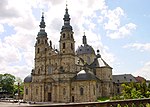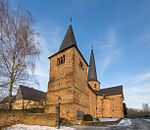Fulda
Fulda | |
|---|---|
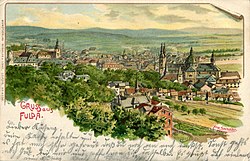 Postcard of Fulda c. 1860–1926 | |
 Coat of arms | |
show Location of Fulda within Fulda district | |
 Fulda | |
| Coordinates: 50°33′3″N 9°40′31″E / 50.55083°N 9.67528°ECoordinates: 50°33′3″N 9°40′31″E / 50.55083°N 9.67528°E | |
| Country | Germany |
| State | Hesse |
| Admin. region | Kassel |
| District | Fulda |
| Founded | 744 |
| Government | |
| • Lord mayor (2021–27) | Dr. Heiko Wingenfeld[1] (CDU) |
| Area | |
| • Total | 104.04 km2 (40.17 sq mi) |
| Elevation | 261 m (856 ft) |
| Population (2020-12-31)[2] | |
| • Total | 67,980 |
| • Density | 650/km2 (1,700/sq mi) |
| Time zone | UTC+01:00 (CET) |
| • Summer (DST) | UTC+02:00 (CEST) |
| Postal codes | 36001–36043 |
| Dialling codes | 0661 |
| Vehicle registration | FD |
| Website | www.fulda.de |
Fulda (German pronunciation: [ˈfʊlda]) (historically in English called Fuld) is a town in Hesse, Germany; it is located on the river Fulda and is the administrative seat of the Fulda district (Kreis). In 1990, the town hosted the 30th Hessentag state festival.
History[]
Middle Ages[]
This section does not cite any sources. (April 2017) |
In 744 Saint Sturm, a disciple of Saint Boniface, founded the Benedictine monastery of Fulda as one of Boniface's outposts in the reorganization of the church in Germany. It later served as a base from which missionaries could accompany Charlemagne's armies in their political and military campaigns to fully conquer and convert pagan Saxony.
The initial grant for the abbey was signed by Carloman, Mayor of the Palace in Austrasia (in office 741–47), the son of Charles Martel. The support of the Mayors of the Palace, and later of the early Pippinid and Carolingian rulers, was important to Boniface's success. Fulda also received support from many of the leading families of the Carolingian world. Sturm, whose tenure as abbot lasted from 747 until 779, was most likely related to the Agilolfing dukes of Bavaria.
Fulda also received large and constant donations from the Etichonids, a leading family in Alsace, and from the Conradines, predecessors of the Salian Holy Roman Emperors. Under Sturm, the donations Fulda received from these and other important families helped in the establishment of daughter-houses near Fulda.

After his martyrdom by the Frisians, the relics of Saint Boniface were brought back to Fulda. Because of the stature this afforded the monastery, the donations increased, and Fulda could establish daughter-houses further away, for example in Hamelin. Meanwhile, Saint Lullus, successor of Boniface as archbishop of Mainz, tried to absorb the abbey into his archbishopric, but failed. This was one reason he founded Hersfeld Abbey – to limit the attempts of the enlargement of Fulda.

Between 790 and 819 the community rebuilt the main monastery church to more fittingly house the relics. They based their new basilica on the original 4th-century (since demolished) Old St. Peter's Basilica in Rome, using the transept and crypt plan of that great pilgrimage church to frame their own saint as the "Apostle to the Germans".
The crypt of the original abbey church still holds those relics, but the church itself has been subsumed into a Baroque renovation. A small, 9th-century chapel remains standing within walking distance of the church, as do the foundations of a later women's abbey. Rabanus Maurus served as abbot at Fulda from 822 to 842.
Counter-Reformation[]
Prince-abbot Balthasar von Dernbach adopted a policy of counter-reformation. In 1571 he called in the Jesuits to found a school and college. He insisted the members of the chapter should return to a monastic form of life. Whereas his predecessors had tolerated Protestantism, resulting in most of the citizenry of Fulda and a large portion of the principality's countryside professing Lutheranism, Balthasar ordered his subjects either to return to the Catholic faith or leave his territories.[3] He also ordered the Fulda witch trials, in which crypto-protestans were executed on charges of witchcraft.[4]
18th and 19th centuries[]
The foundation of the abbey of Fulda and its territory originated with an Imperial grant, and the sovereign principality therefore was subject only to the German emperor. Fulda became a bishopric in 1752 and the prince-abbots were given the additional title of prince-bishop. The prince-abbots (and later prince-bishops) ruled Fulda and the surrounding region until the bishopric was forcibly dissolved by Napoleon I in 1802.[citation needed]
The city went through a baroque building campaign in the 18th century, resulting in the current "Baroque City" status. This included a remodeling of Fulda Cathedral (1704–12) and of the Stadtschloss (Fulda Castle-Palace, 1707–12) by Johann Dientzenhofer. The city parish church, St. Blasius, was built between 1771 and 1785. In 1764 a porcelain factory was started in Fulda under Prince-Bishop, Prince-Abbot Heinrich von Bibra, but shortly after his death it was closed down in 1789 by his successor, Prince-Bishop, Prince-Abbot Adalbert von Harstall.[citation needed]
The city was given to Prince William Frederick of Orange-Nassau (the later King William I of the Netherlands) in 1803 (as part of the short-lived Principality of Nassau-Orange-Fulda), was annexed to the Grand Duchy of Berg in 1806, and in 1809 to the Principality of Frankfurt. After the Congress of Vienna of 1814–15, most of the territory went to the Electorate of Hesse, which Prussia annexed in 1866.[5]
Cold War[]
Fulda lends its name to the Fulda Gap, a traditional east–west invasion route used by Napoleon I and others. During the Cold War, it was presumed to be an invasion route for any conventional war between NATO and Soviet forces. Downs Barracks in Fulda was the headquarters of the American 14th Armored Cavalry Regiment, later replaced by the 11th Armored Cavalry Regiment. The cavalry had as many as 3,000 soldiers from the end of World War II until 1993. Not all those soldiers were in Fulda proper, but scattered over observation posts and in the cities of Bad Kissingen and Bad Hersfeld. The strategic importance of this region, along the border between East and West Germany, led to a large United States and Soviet military presence.[6]
Mayors[]
Department I (head and personnel administration, finance, committee work, culture, business development, city marketing, investments)
- Cuno Raabe (CDU):1946–1956
- Alfred Dregger (CDU): 1956–1970
- Dr. Wolfgang Hamberger (CDU): 1970–1998
- Dr. Alois Rhiel (CDU): 1998–2003
- Gerhard Möller (CDU): 2003–2015
- Heiko Wingenfeld (CDU): 2015–
Department II (public security and order, family, youth, schools, sports, social affairs, seniors)
- Karl Ehser: 1934–1945
- Karl Schmitt: 1946–1948
- Heinrich Gellings: 1948–1969
- Dr. Wolfgang Hamberger: 1969–1970
- Dr. Tilman Pünder: 1971–1980
- Lutz von Pufendorf: 1981–1984
- Dr. Alois Rhiel: 1984–1989
- Josef H. Mayer: 1990–1995
- Oda Scheibelhuber: 1995–1999
- Bernd Woide: 1999–2003
- Dr. Wolfgang Dippel: 2004–2014
- Dag Wehner (CDU): 2014–
Source:[7]
Transport[]
Fulda station is a transport hub and interchange point between local and long-distance traffic of the German railway network, and is classified by Deutsche Bahn as a category 2 station.[8] It is on the Hanover–Würzburg high-speed railway; the North–South line (Nord-Süd-Strecke), comprising the Bebra–Fulda line north of Fulda, and the Kinzig Valley Railway and to the south; the Vogelsberg Railway, which connects to the hills of the Vogelsberg in the west; and the Fulda–Gersfeld Railway (Rhön Railway) to Gersfeld in the Rhön Mountains to the east.
Fulda is on the Bundesautobahn 7 (BAB 7). Bundesautobahn 66 starts at the interchange with the BAB 7, heading south towards Frankfurt. Fulda is also on the Bundesstraße 27.
Twin towns – sister cities[]
Fulda is twinned with:[9]
 Como, Italy (1960)
Como, Italy (1960) Arles, France (1964)
Arles, France (1964) Sergiyev Posad, Russia (1991)
Sergiyev Posad, Russia (1991) Wilmington, United States (1997)
Wilmington, United States (1997) Litoměřice, Czech Republic (2001)
Litoměřice, Czech Republic (2001) Dokkum, Netherlands (2013)
Dokkum, Netherlands (2013)
Notable people[]
pre-1800[]

- Adam of Fulda (c. 1445–1505), composer and music theorist
- Adam Krafft (1493–1558), Protestant church reformer
- Justus Menius (1499–1558), theologian
- Franz Kaspar Lieblein (1744–1810), botanist
1801–1850[]
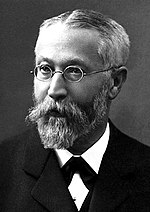
- Georg von Adelmann (1811–1888), physician and surgeon
- Otto Bähr (1817–1895), lawyer and politician
- Hugo Staehle (1826–1848), composer
- Ferdinand Braun (1850–1918), physicist, electrical engineer and Nobel laureate in physics
1851–1900[]
- Adalbert Ricken (1851–1921), mycologist and priest
- Ludwig Hupfeld (1864–1949), instrument maker and industrialist
- Wilhelm Heye (1869–1947), officer
- Clara Harnack (1877–1962), painter, teacher and mother of the resistance fighters Arvid and Falk Harnack
- Anton Storch (1892–1975), politician
- Wilm Hosenfeld (1895–1952), officer and Righteous Among the Nations
- Paul Deichmann (1898–1981), officer of the Luftwaffe
- Max Stern (1898–1982), businessman, investor and philanthropist
1901–1950[]
- Karl Storch (1913–1992), athlete (hammer thrower)
- Wilhelm Balthasar (1914–1941), Air Force officer
- Fr. Gereon Goldmann (1916–2003), Franciscan priest and World War II veteran
- (1935–2001), philosopher and medievalist
- Martin Hohmann (born 1948), politician (CDU, now AfD)
- Winfried Michel (born 1948), composer, recorder player and music publisher
1951–present[]
- Immanuel Bloch (born 1972), physicist
- Tobias Sammet (born 1977), musician
- Sebastian Kehl (born 1980), football player
- Patrik Sinkewitz (born 1980), professional cyclist
- Damien Haas (born 1990), actor
Gallery[]

City palace garden

Statue of Saint Boniface (1830) in Fulda

Fulda in 1850
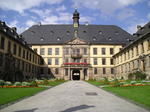
Entrance of the Stadtschloss (City Palace)
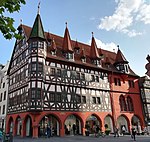
Old City Hall
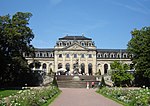
Orangerie
Kloster Frauenberg (Fulda), a Franciscan monastery

Baroque Adelspalais
Old University of Fulda: Adolphs-Universität Fulda

Looking east toward Fulda over the rich farmlands

Weser river watershed, showing Fulda river and the city of Fulda

St. Paul's Gate, viewed from the south
See also[]
References[]
- ^ Direkt gewählte (Ober-) Bürgermeister/-innen der hessischen Städte und Gemeinden, accessed 5 July 2021.
- ^ "Bevölkerung in Hessen am 31.12.2020 nach Gemeinden". Hessisches Statistisches Landesamt (in German). June 2021.
- ^ Otto Schaffrath. Fürstabt Balthasar von Dermbach und seine Zeit. Studien zur Geschichte der Gegenreformation in Fulda (= Veröffentlichung des Fuldaer Geschichtsvereins. Bd. 44, ZDB-ID 517272-x). Parzeller, Fulda 1967, mit umfangreicher Literaturübersicht.(in German)
- ^ Stuart Clark, William Monter, Witchcraft and Magic in Europe, Volume 4: The Period of the Witch Trials
- ^ One or more of the preceding sentences incorporates text from a publication now in the public domain: Ripley, George; Dana, Charles A., eds. (1879). . The American Cyclopædia.
- ^ Brown, Jerold E., ed. (2001). Historical Dictionary of the U.S. Army. Westport, CT: Greenwood Publishing Group. pp. 209–10. ISBN 9780313293221.
- ^ "Mayor" City of Fulda website
- ^ "Stationspreisliste 2021" [Station price list 2021] (PDF) (in German). DB Station&Service. 16 November 2020. Retrieved 3 December 2020.
- ^ "Partnerstädte". fulda.de (in German). Fulda. Retrieved 2019-11-30.
External links[]
| Wikimedia Commons has media related to Fulda. |
| Wikivoyage has a travel guide for Fulda. |
- Towns in Hesse
- Fulda
- Fulda (district)
- Hesse-Nassau
- Populated places established in the 8th century
- 8th-century establishments in Germany
- 744 establishments
- Christian monasteries established in the 12th century
- 12th-century establishments in Germany
- Carolingian architecture
- Counter-Reformation
- Historic Jewish communities





